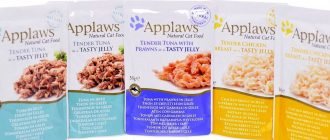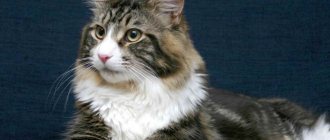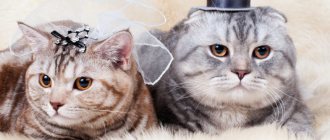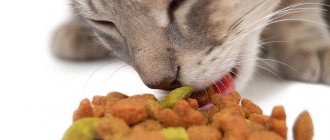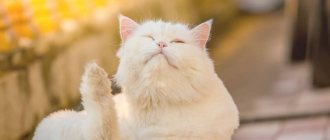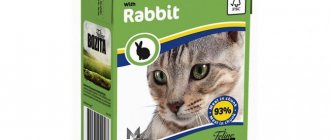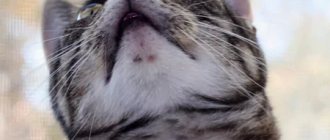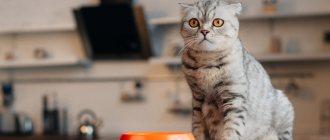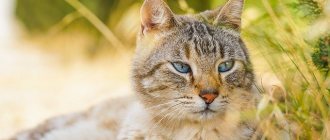We offer to buy cat food for weight loss in the 12 Monkeys online store at a low price. Obesity in pets often leads to serious health problems. Cats are especially susceptible to the accumulation of excess weight, including due to many diseases, castration, a sedentary lifestyle and improper nutrition. If you are faced with such a problem, food for cats prone to obesity, presented in this section of our website, will help you cope with it.
The danger of excess weight for cats and kittens
Not all owners think that excess body weight in a furry baby is not a reason to be touched, but a serious illness that requires immediate treatment and a review of the diet. If the cat has no waist, it is impossible to palpate the bony protrusions of the vertebrae and ribs, and a large and dense fold forms at the withers, the diet should be changed. Fat is also deposited in internal organs, which leads to the development of undesirable consequences, which include:
- Disruption of the heart and blood vessels. With excess body weight, the heart muscle spends much more energy contracting and moving an increased amount of blood. Obesity also contributes to the formation of atherosclerotic plaques in the lumen of blood vessels - growths that disrupt normal blood flow through arteries and veins. As a result, a lack of oxygen (hypoxia) develops in the soft tissues.
- Problems with the respiratory system. Overweight cats are much more likely to suffer from shortness of breath and get tired faster even with little physical activity. This is due to the fact that the fat layer puts pressure on the diaphragm and lungs of the animal.
- Damage to the pancreas and impaired carbohydrate metabolism. Due to insufficient synthesis of the hormone insulin, excess glucose is formed in the cat's body and diabetes mellitus occurs. At the same time, the animal may develop other serious problems against the background of such a disease (damage to blood vessels, visual impairment).
- Fatty degeneration of internal organs. Against the background of excess body weight, a pathological process begins in the cat’s body, as a result of which the liver, kidneys, and pancreas suffer and multiple organ failure can develop, leading to death.
- Joint problems. Due to increased body weight, the load on the upper and lower limbs increases sharply. Obesity causes curvature of the paws and increases the risk of developing sprains and ruptures of ligaments and tendons. Against the background of constant pain, cats practically stop moving, which leads to an even greater increase in excess weight: a vicious circle is created.
It is believed that the presence of extra pounds reduces the lifespan of a furry pet by at least 3-4 years.
Photo gallery: cats suffering from obesity
Sphynx cats are less likely to become obese due to their high metabolic rate
With obesity, the border between the head and neck becomes difficult to distinguish
A cat's lack of waist indicates obesity
Video: veterinarian talks about obesity in pets
First, visit the veterinarian
Contacting a specialist is an important point in the desire to help your pet. Owners do not always understand what the optimal body weight of their pet should be. For example, the constitution of the Persian representatives is very different from the lean Siamese. It would seem that everything is very simple - you need to feed the animal less, and the weight will decrease.
Unfortunately, not everything is so obvious. You should not put your cat on a diet without first consulting a specialist. Even a two-day hunger can be dangerous for an animal. It leads to irreversible damage to the liver and kidneys.
To begin with, the mustachioed fatty must be examined by a veterinarian. If necessary, he prescribes additional laboratory tests of the patient’s blood or urine. Tests can help identify hidden diseases or other problems that are preventing you from losing fat. Sometimes an animal’s illness or its advanced age become serious contraindications for prescribing a diet.
Nutritional considerations for overweight cats
When fighting obesity in a pet, you need to follow the same rule as in humans: calorie expenditure should exceed their intake. This is the only way to get your cat in shape and avoid the development of complications due to excess weight. Pet owners can consider two options: special medicinal food or natural food (natural food), each of which has advantages and disadvantages.
Table: pros and cons of different forms of nutrition
| Straight | Cat food | ||
| Advantages | Flaws | Advantages | Flaws |
| Low cost | The need to calculate the amount of calories, proteins, fats and carbohydrates | Veterinarian-proven effectiveness in treating obesity or dystrophy in cats | High cost (especially premium food) |
| Possibility of cooking at home (confidence in the composition) | Cooking time costs | Possibility to choose various flavorings and additives | Inability to check the composition yourself |
| Food can be of any consistency | Limited food options (not always suitable for cats with allergies) | Many brands of manufacturers (you can choose food for each pet based on individual characteristics) | Only solid or jelly-like consistency |
Which food to choose
If cats are obese, it is better to use expensive food with the most natural composition. They should contain the amount of proteins, fats, carbohydrates, vitamins and minerals that the cat needs, as well as plant fibers. This will help avoid forced starvation and nutritional deficiencies.
It is better to use dry food for feeding obese cats: the animal chews hard pieces more slowly, which contributes to satiety. And also after such a snack, your pet will definitely drink water, which also reduces space in the stomach.
How to properly transfer an animal to diet food
A sudden change in the usual diet can cause serious stress in your pet, which will also negatively affect its health. That is why it is necessary to switch to dietary nutrition gradually: over 7–9 days in young animals and about 10–12 days in older ones. Basic principles of cat adaptation:
- Every day, add 1 teaspoon of new food, proportionally reducing the amount of old. At the same time, there is no need to force the cat to finish eating if it does not like the new food. If you are switching from natural to food or vice versa, adhere to the same principle: introduce new products gradually.
- When changing wet food to dry food, you can soak it a little (especially for old cats or very young kittens). To do this, use water or low-fat broths.
- In the first few days, the animal may experience a change in stool consistency. If this symptom lasts for a week, you should contact your veterinarian and change the diet.
The transition from one food to another is carried out gradually
A feeder with a timer will be a useful purchase for owners of cats suffering from obesity. One of my friends worked all day and was unable to feed his pet regularly. Previously, he poured him a large bowl of food, which the cat ate within several hours, and in the evening he received another huge portion, which contributed to the appearance of excess weight. The solution to this problem was a feeder with a timer: at a certain time it poured out the required amount of food. This helped the cat not only lose weight, but also normalize his food intake by the hour.
What to do if your pet constantly asks for food
When organizing meals for obese cats, it is important to consider that their stomach is slightly larger than normal. This means that if they reduce their usual serving size, they may experience significant discomfort. In this case, it is recommended to increase the number of feedings, but reduce the amount of food the cat consumes. Veterinarians advise strictly adhering to nutritional standards and not following your pet’s lead, since even a slight excess of calories can reduce all the results of the diet to zero.
The animal should always have drinking water freely available. Many cats confuse hunger with thirst, resulting in them eating extra food in an attempt to compensate for the fluid deficiency.
Do not forget about rewards: even if you are overweight, you should not deprive your pet of his favorite treat. One of my colleagues had a Scottish Fold cat who suffered from obesity and was put on a strict diet. But every day the owner gave him 3-5 catnip pads, which helped suppress his appetite and hold on until the next meal. In this way, two goals were achieved at once: the cat did not ask for food and experienced pleasure from the treat.
Organization of natural nutrition for an obese cat
When feeding natural products, it is worth considering that your pet is primarily a carnivore, and the basis of its diet should be animal proteins. You should not sharply limit the amount of fat or switch your cat only to plant-based foods: this can lead to the development of serious liver and stomach diseases.
Veterinarians also do not advise mixing natural food and food: the animal must be accustomed to one type of food. You should also not add salt, other seasonings or flavor enhancers to animal dishes.
Nutrition for obese cats:
- The source of proteins and fats and the main food product is meat (beef, chicken, turkey) and offal (liver, hearts). It is better to avoid pork and lamb - they are too fatty for the cat’s gastrointestinal tract and are difficult to digest. The meat can be given raw in the form of cubes or boiled.
- Fish for cat food is used no more than 1-2 times a week, only sea fish, with a small amount of fat (pink salmon, salmon, trout). It needs to be boiled, scales and bones removed so that the animal does not choke or get injured while eating.
- Dairy products are a source of calcium, so they should also be included in the diet. To feed overweight cats, it is better to choose low-fat yogurt, kefir or cottage cheese.
- Cereals are used as a source of slow carbohydrates. For pets, you can cook oatmeal, buckwheat, rice, barley in water or lean broth.
- Vegetables are also good for the cat's body, as they contain many carbohydrates, vitamins and minerals, and they are also rich in fiber, which improves digestion. Your pet's diet should include carrots, green beans, zucchini, pumpkin, broccoli, asparagus and any greens (lettuce, celery, parsley, dill, green onions). It is better to boil vegetables or serve them raw, cut into small pieces.
Photo gallery: healthy foods when feeding natural food
Vegetables are rich in vitamins and minerals
Cottage cheese is the best source of calcium
Meat is rich in animal protein
General tips for shaping your diet
To properly organize feeding your pet, you must adhere to the following rules:
- The weight of food consumed daily should be calculated by a veterinarian based on information about the cat’s breed, age and degree of obesity. On average, this amount does not exceed 3–5% of the animal’s body weight (in sphinxes this value may be increased due to excess heat production in the body).
- Food should be given in small portions at strictly defined times (it is better if at this moment you yourself eat or have a snack). It is recommended to feed your cat every 3 hours (for example, at 8, 11, 14, 17, 21, 24 hours), you can use a feeder with a timer for this.
- Do not give your pet pieces from the table and stop begging from guests. This could cause your fur baby to beg for his favorite treat and ruin his diet.
How long should you stick to this diet?
Your cat's weight loss should occur gradually. With strict adherence to the diet and dosed physical activity, your pet can lose excess weight within 5-9 months. If you have been adhering to the restrictions for more than a year, and the animal’s weight remains the same, you need to reconsider the diet and choose different food or other products for natural nutrition.
Recipe No. 5
Milk breakfast:
- Powdered milk - 1 tbsp. spoon.
- Chicken eggs - 2 pcs.
- Cottage cheese - 3 tbsp. spoons.
- Chopped vegetables - 2 tbsp. spoons.
Add a few tablespoons of cold water to the milk powder, then beat in the eggs and bring the mixture until smooth. Gradually stir in cottage cheese and vegetables. Pour the mixture into the pan and cook for 2 minutes on each side. Cool, cut and serve to your pet.
Milk breakfast
Attention! Remember, no salt or spices should be used in any recipe. They will irritate the animal’s receptors, which will negatively affect its sense of smell and perception of taste.
Table: comparison of food for overweight cats
| Name of food | Class | View | Features of the composition | Effect | Price |
| Monge Vetsolution Cat Obesity | Superpremium | Dry | Psyllium seed husk | Slowing down the emptying of the gastrointestinal tract, causing the cat to feel full |
|
| Farmina Vet Life Obesity | Superpremium | Dry | Beet pulp, flax seeds, dehydrated meat, vegetable oil | Promotes weight loss and normalization of stool |
|
| Royal Canin Light Weight Care | Premium | Dry | Psyllium fiber, L-carnitine | Reducing spontaneous food consumption |
|
| Royal Canin Ultra Light | Premium | Wet (jelly) | Meat and grains | Normalization of the gastrointestinal tract | 650 RUR (0.09 kg) |
| Royal Canin Satiety Weight Management | Premium | Dehydrated poultry, vegetable fibre, wheat and corn gluten | Maintains normal weight after weight loss |
| |
| Brit Care Cat Daisy I've to control my Weight | Superpremium | Dry | Soluble fiber from beets and psyllium | Prevents the deposition of unwanted fats from food | 900 RUR (2 kg). |
| Pro Plan Light | Premium | Dry | Turkey, rice, amino acid mixture | Keeping your cat in perfect shape regardless of physical activity level | 1010 RUR (1.5 kg). |
| Hill's Science Plan Perfect Weight | Premium | Dry | Prebiotic fiber, poultry meal, coconut oil | Improves nutrient absorption and eases digestion | 1700 RUR (1.5 kg). |
| Hill's Science Plan Adult Light | Premium | Dry | Meat, cellulose, gluten, antioxidants | Normalization of the stomach and intestines, weight loss | 1200 RUR (1.5 kg). |
| 1st Choice Weight Control | Superpremium | Dry | L-carnitine, plant fibers, taurine | Maintains ideal shape thanks to a reduced amount of fat, reduces the risk of developing urolithiasis |
|
| Barking Heads Adult Fat Cat Slim | Holistic | Dry | Chicken and salmon, eggs, tomatoes, carrots | Cleanses the intestines and removes toxins, facilitating the absorption of nutrients |
|
| Bosch Sanabelle Light | Superpremium | Dry | Poultry, rice, millet | Normalization of metabolic processes in the pet’s body |
|
Photo gallery: foods used to treat obesity
Monge Vetsolution Cat Obesity creates a feeling of fullness in a cat
Bosch Sanabelle Ligh contains only natural ingredients
Royal Canin Ultra Light comes in jelly form
Brit Care Cat Daisy I've to control my Weight promotes weight loss
How long does it take to train a cat to go on a diet?
Give your cat a week or two to get used to the new diet. First, mix ¼ of the new food with ¾ of the usual food for 2 to 4 days. Then increase the amount of new food to half, and in the last 3 to 5 days before the final transition to the new diet - to ¾.
To improve palatability, you can heat the food and add flavoring additives, for example, based on fish oil containing Omega-3 fatty acids.
If your cat refuses a new diet, or if you have any questions while introducing her to a new food, do not hesitate to contact your veterinarian for advice.
How to identify excessive thinness in a pet
Due to the large number of breeds, many cats have significant differences in appearance. This is why some people may mistake a slender and lean animal for an emaciated one. You need to know the difference between physiological and pathological thinness.
Signs of a healthy cat with a slender physique:
- the proportions between the sizes of the head, torso and limbs are observed;
- ribs and vertebrae are not visible through the layer of wool, but are easily found when palpated;
- the waist is pronounced;
- there is a thin layer of fat in the chest and abdomen area;
- the animal is active, plays a lot and eats with appetite;
- The coat is smooth, shiny, easy to comb and does not fall out.
Oriental breed cats have well-developed muscle mass and a small layer of fat
With pathological thinness, the following signs are observed:
- protruding shoulder blades, ribs, hip bones are visible to the naked eye;
- the head and ears are sharply enlarged compared to the body, the limbs are thin;
- the muscles are poorly developed, fatty tissue on the abdomen and back cannot be felt;
- the fur falls out in uneven tufts, there may be tangles;
- the animal spends a lot of time sleeping, moves little, and changes in appetite are observed (ravenous hunger or complete lack of desire to eat).
When a cat is emaciated, bones can be seen through the skin.
Sources of fats
This element must be included in a cat’s natural diet, since it is not only, along with carbohydrates, a source of energy, but also supplies the body with many vitamins:
- A - improves vision, is responsible for the condition of the skin and coat;
- D - is of great importance for the formation of the skeleton;
- E - strengthens muscles, regulates the normal functioning of the genitourinary system;
- K - is an important element for strengthening joints and bones, and the functioning of the cardiovascular system.
In addition, fats give food an attractive taste and smell, promote intensive growth and harmonious development of the animal. Their share in the pet’s diet with natural nutrition should be at least 20%.
If it is not possible to provide the animal with food with a sufficient amount of these components, then fish oil can be added to it.
Table: Comparison of cat foods that promote weight gain
| Name of food | Class | View | Features of the composition | Effect | Price |
| Royal Canin Recovery | Premium | Wet | Poultry liver, corn starch, taurine, vitamins | Improved absorption of nutrients | 1200 RUR (195 g). |
| ProPlan Convalescence Support Cat | Premium | Wet | Pork or poultry, dried egg white, minerals | Proteins, fats and carbohydrates are better absorbed | 60 r (100 g). |
| Hill's a/d | Superpremium | Wet | Turkey liver, chicken, pork, fish oil | Stimulation of metabolic processes, weight gain | 120 RUR (156 g). |
| Applaws Chicken & Duck | Superpremium | Wet | Chicken meat, chicken broth, duck fillet | Restoring body weight, preventing excess weight loss |
|
Photo gallery: foods that promote weight gain
Applaws Chicken & Duck promotes weight gain
Hill's a/d improves the recovery of an exhausted cat
Royal Canin Recovery helps you maintain your desired weight
Recipe No. 2
Fresh meat for lunch:
- Chicken breast - 100 g.
- Lean pork meat (can be replaced) - 30 g.
- Rice - 1 tbsp. spoon.
- Chopped parsley - a handful.
- Vegetable oil - 1 teaspoon.
Chop the meat with a knife and mix with the rest of the ingredients. Store for no more than 2 days.
Fresh meat for lunch
How to gain weight for a cat using natural food
Natural oil is also used to combat exhaustion. Owners should remember that underweight cats should also receive food in small portions 5-6 times a day in liquid or jelly form, so as not to cause stomach distension and vomiting. You should also not sharply increase the amount of fat in your diet: this can damage the liver.
What should be given to an animal to gain body weight:
- veal, chicken;
- oatmeal, rolled oats and bran;
- liver;
- baby food based on vegetables and meat;
- dairy products (butter, sour cream, yogurt without additives or dyes);
- egg yolk (no more than 1-2 times a week).
Do not forget that even severely emaciated cats should not eat from the home table. One of my friends decided that country milk would be suitable for his old 18-year-old cat to gain weight. After the pet was fed, he suddenly lost his stool. With age, the amount of biologically active substances (enzymes) that contribute to the breakdown of milk fats decreases in the cat’s body. As a result, they are not absorbed, and the animal develops diarrhea, which can threaten the development of dehydration and even death of the pet. The cat was saved only after placing a drip with saline solution. Then the injured animal was switched to a more gentle home diet, which allowed it to be saved from exhaustion and avoid death.
How often are control weighings carried out?
After you have developed a plan together with your veterinarian on how to make your cat lose weight, you need to understand its effectiveness. Each animal is individual, so the result is not always obvious.
On average, a veterinarian advises weighing an obese patient at least once a month. This will make it possible to track your weight loss process. If your weight loss is too slow and no more than 500 g per month, then you should reconsider your weight loss program.
Prevention
There are a few simple rules that will help prevent your beloved mustache from becoming overweight:
Along with appearance, obesity affects internal organs. A problem like this indicates that your friend’s life is shortening. Fatty masses envelop the internal organs and increase the load on the joints and heart.
Pay attention to the quality of the food you give. It’s better to spend money and live with a healthy and active cat than to feed it to obesity and disease, spending even more
Do not mix or alternate natural and dry food. Make a meal schedule and feed strictly according to it. If your cat follows you around and demands dinner at an untimely time, remain persistent and do not give in to provocations. In a week he will get used to it and won’t beg. Don't try to pay off with food. Whiskers, like all pets, require attention, and you should give it. Don’t think that giving him an extra piece of sausage will replace rubbing his tummy. Do not prohibit active games. The pet must be provided with a sufficient amount of exercise. After all, by their nature they are predators and must hunt for food. He may now be a domestic lump, but he has instincts. Watching a sunbeam, playing with a ball or restlessly running around the house is a kind of hunt. Take part in the games, it will be useful for the cat and you yourself will get a boost of positivity by watching the jumping hunter. Change the diet if your pet has undergone sterilization surgery. Such animals require a special diet.
As you can see, preventing obesity is not at all difficult. But if this happens, you must definitely find a way to help your cat lose weight. Don't start with a solution to the problem, you'll only make it worse. Be sure to go for a consultation with a doctor who will tell you how to properly and painlessly return your cat to its former shape.
Show patience, attention and care to your full-eared cat, and together you can achieve results
Increasing physical activity
It is very important for obese cats to increase physical activity
The fat one must move.
Movement is necessary for losing weight. She does not need to suffer either on the treadmill or in cat aerobics classes.
The best gymnastics for Murka is her favorite sport - hunting. So you should awaken the hunter's instincts in the cat.
To do this, you will need a piece of paper folded like an accordion on a string, which can be held either directly in your hand or on a stick “fishing rod” for cats. These animals love to chase such a toy, powered by the owner's hand.
If the animal does not want to chase such a toy, you can take it to the country or simply release it into the yard, where the animal will run and lose fat.
There is also another way: you can put one or two toys in each room, filling them with pieces of dry food taken from the bowl. Let your pet work to get some food. At the same time he will have fun.
Well, the third method: put the bowl in a different place each time (you can repeat it, but don’t put it twice in a row in the same place), and so that the animal has to work with its paws to get to the food.
You can place a bowl of food in different places to encourage your cat to be active.
These animals have good brains. If the cat understands that its “dining room” is on top, it will often go up there and then wait there for the next portion.
If she likes a certain place, place the bowl of food away from there. Many fat cats prefer to rest close to the bowl because they do not like to travel long distances for food.
Cats like variety. That’s why it’s best to change toys and entertainment so that you don’t get tired of them.
